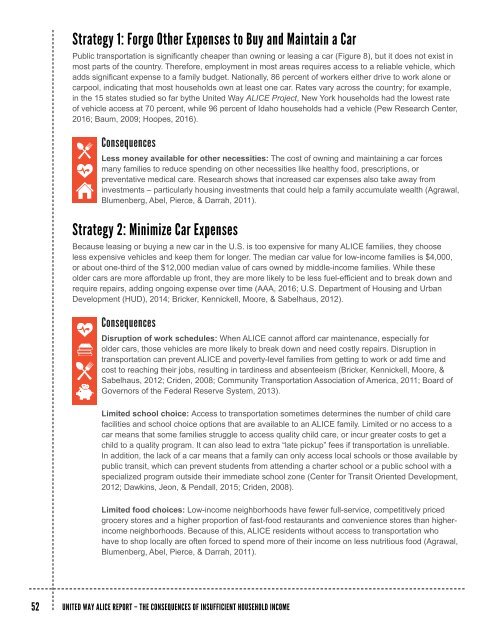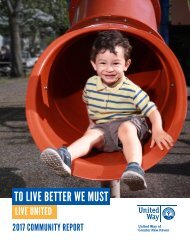The Consequences of Insufficient Household Income
This new Consequences of Insufficient Household Income report provides a deeper level of understanding of the choices that ALICE and poverty-level families across the country make when they do not have enough income or assistance to afford basic necessities, and the consequences of those choices.
This new Consequences of Insufficient Household Income report provides a deeper level of understanding of the choices that ALICE and poverty-level families across the country make when they do not have enough income or assistance to afford basic necessities, and the consequences of those choices.
You also want an ePaper? Increase the reach of your titles
YUMPU automatically turns print PDFs into web optimized ePapers that Google loves.
Strategy 1: Forgo Other Expenses to Buy and Maintain a Car<br />
Public transportation is significantly cheaper than owning or leasing a car (Figure 8), but it does not exist in<br />
most parts <strong>of</strong> the country. <strong>The</strong>refore, employment in most areas requires access to a reliable vehicle, which<br />
adds significant expense to a family budget. Nationally, 86 percent <strong>of</strong> workers either drive to work alone or<br />
carpool, indicating that most households own at least one car. Rates vary across the country; for example,<br />
in the 15 states studied so far bythe United Way ALICE Project, New York households had the lowest rate<br />
<strong>of</strong> vehicle access at 70 percent, while 96 percent <strong>of</strong> Idaho households had a vehicle (Pew Research Center,<br />
2016; Baum, 2009; Hoopes, 2016).<br />
<strong>Consequences</strong><br />
Less money available for other necessities: <strong>The</strong> cost <strong>of</strong> owning and maintaining a car forces<br />
many families to reduce spending on other necessities like healthy food, prescriptions, or<br />
preventative medical care. Research shows that increased car expenses also take away from<br />
investments – particularly housing investments that could help a family accumulate wealth (Agrawal,<br />
Blumenberg, Abel, Pierce, & Darrah, 2011).<br />
Strategy 2: Minimize Car Expenses<br />
Because leasing or buying a new car in the U.S. is too expensive for many ALICE families, they choose<br />
less expensive vehicles and keep them for longer. <strong>The</strong> median car value for low-income families is $4,000,<br />
or about one-third <strong>of</strong> the $12,000 median value <strong>of</strong> cars owned by middle-income families. While these<br />
older cars are more affordable up front, they are more likely to be less fuel-efficient and to break down and<br />
require repairs, adding ongoing expense over time (AAA, 2016; U.S. Department <strong>of</strong> Housing and Urban<br />
Development (HUD), 2014; Bricker, Kennickell, Moore, & Sabelhaus, 2012).<br />
<strong>Consequences</strong><br />
Disruption <strong>of</strong> work schedules: When ALICE cannot afford car maintenance, especially for<br />
older cars, those vehicles are more likely to break down and need costly repairs. Disruption in<br />
transportation can prevent ALICE and poverty-level families from getting to work or add time and<br />
cost to reaching their jobs, resulting in tardiness and absenteeism (Bricker, Kennickell, Moore, &<br />
Sabelhaus, 2012; Criden, 2008; Community Transportation Association <strong>of</strong> America, 2011; Board <strong>of</strong><br />
Governors <strong>of</strong> the Federal Reserve System, 2013).<br />
Limited school choice: Access to transportation sometimes determines the number <strong>of</strong> child care<br />
facilities and school choice options that are available to an ALICE family. Limited or no access to a<br />
car means that some families struggle to access quality child care, or incur greater costs to get a<br />
child to a quality program. It can also lead to extra “late pickup” fees if transportation is unreliable.<br />
In addition, the lack <strong>of</strong> a car means that a family can only access local schools or those available by<br />
public transit, which can prevent students from attending a charter school or a public school with a<br />
specialized program outside their immediate school zone (Center for Transit Oriented Development,<br />
2012; Dawkins, Jeon, & Pendall, 2015; Criden, 2008).<br />
Limited food choices: Low-income neighborhoods have fewer full-service, competitively priced<br />
grocery stores and a higher proportion <strong>of</strong> fast-food restaurants and convenience stores than higherincome<br />
neighborhoods. Because <strong>of</strong> this, ALICE residents without access to transportation who<br />
have to shop locally are <strong>of</strong>ten forced to spend more <strong>of</strong> their income on less nutritious food (Agrawal,<br />
Blumenberg, Abel, Pierce, & Darrah, 2011).<br />
52 UNITED WAY ALICE REPORT – THE CONSEQUENCES OF INSUFFICIENT HOUSEHOLD INCOME




